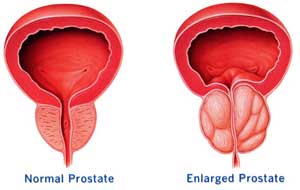A lot of publicity has been given to heat and laser treatment for BPH, so much so that patients may be disappointed when they find that they cannot have this done in their local hospital. Heat treatment, ‘hypothermia’ or ‘thermotherapy’, heats up the prostate. The treatment is given through a probe placed either in the back passage or in the urethra. Early types only warmed the prostate a little and only had a small effect, although patients’ symptoms did often improve. It is now possible to heat up the prostate a lot more without affecting the surrounding organs, and the results are more promising. The effects are probably closer to those produced by drugs than by a TURP and heat treatment is unlikely to become an alternative to TURP for men with severe BPH.
Laser treatment is more like a TURP, and is an alternative way of removing the enlarged part of the prostate, or of simply cutting it open to widen it. There are a number of different ways of applying laser treatment. Although laser treatment in medicine is topical and receives much publicity, urologists are yet to agree on the best way to use lasers on the prostate or even whether it will prove to be a useful treatment in the long run. There is now a similar treatment called ‘vaporisation’ that uses a slight modification of the resectoscope instrument used for a TURP.
 The advantage of many of these treatments is that they can be used in outpatients. However, often it is necessary for the patient to have a catheter in the bladder for several days after treatment and the long-term effects are uncertain. As they are ‘new’ they are not necessarily better. Although their advantages and disadvantages are becoming understood, most urologists still feel that these new treatments need more testing before they can be generally recommended. This is one reason why they are not widely available; the other is that the equipment needed is often expensive and hospitals will want to know how well the treatment works before buying it. Where such a treatment is suggested, it will probably made clear that it is ‘on trial’.
The advantage of many of these treatments is that they can be used in outpatients. However, often it is necessary for the patient to have a catheter in the bladder for several days after treatment and the long-term effects are uncertain. As they are ‘new’ they are not necessarily better. Although their advantages and disadvantages are becoming understood, most urologists still feel that these new treatments need more testing before they can be generally recommended. This is one reason why they are not widely available; the other is that the equipment needed is often expensive and hospitals will want to know how well the treatment works before buying it. Where such a treatment is suggested, it will probably made clear that it is ‘on trial’.
‘Stents’ are short tubes, usually made of inert metal mesh, which are placed in the prostate to keep it open. They can be put in with very little disturbance often under local anaesthetic. A stent might be used in a man who is too unfit for an operation to avoid him having to be catheterised permanently. However, they can often cause long-term problems and are used less now than a few years ago.
